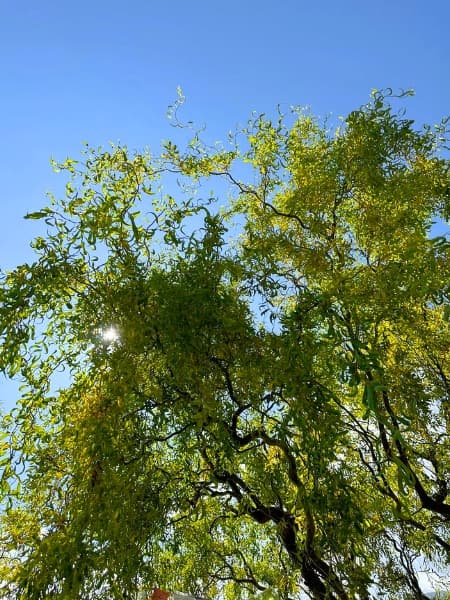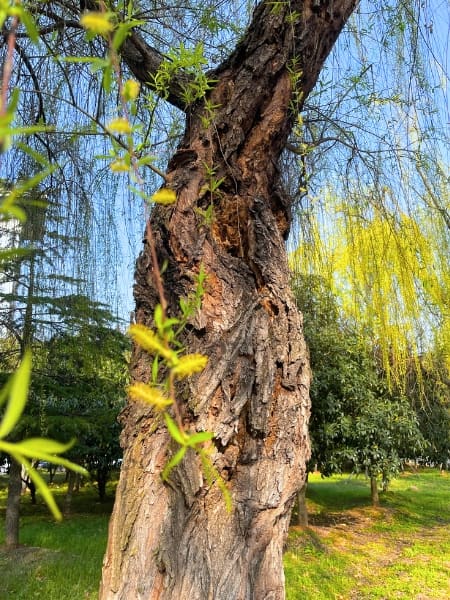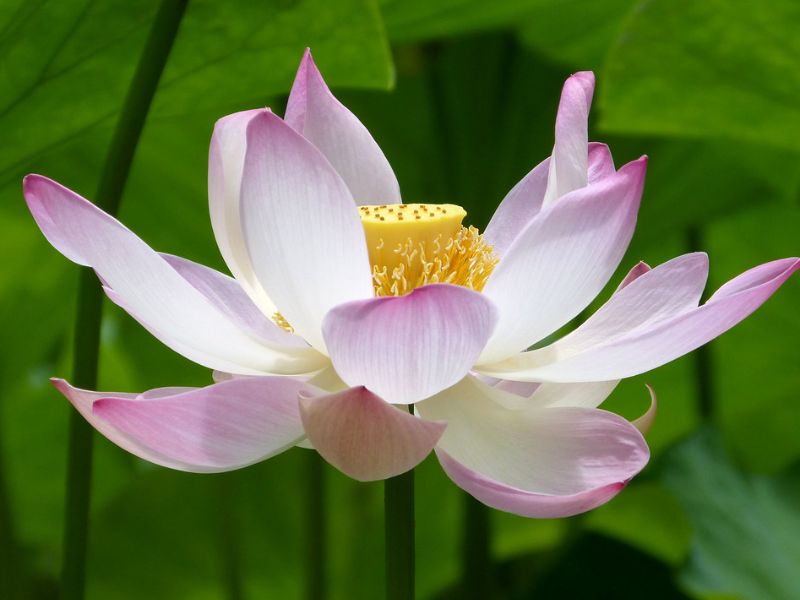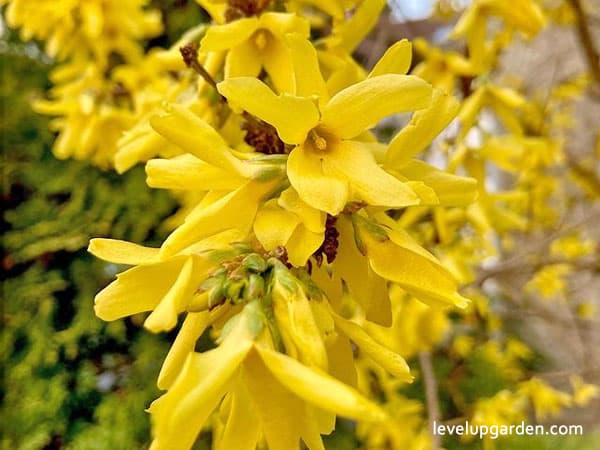The corkscrew willow tree, Salix matsudana, is an embodiment of nature’s whimsicality. Its defining feature, the twisty branches, reminiscent of a corkscrew, stands out especially in winter. The orange-yellow branches intertwining and contorting in every direction add a striking gnarly texture to any garden or landscape. Beyond its winter spectacle, the tree flourishes in spring with budding sprouts, offers a cool shade with its lush leaves in summer, and paints the landscape with vibrant yellow hues in autumn.
Not only does its aesthetic appeal make it a coveted choice for garden enthusiasts, but the corkscrew willow also boasts practical advantages. It’s a resilient tree resistant to deer and largely free from common diseases and pests. Even during the colder months, it stands tall and unfazed, enduring temperatures as low as -20 degrees Fahrenheit. Plus, its adaptability means it thrives in a variety of settings – from full sun to partial shade, in diverse soil types, and even in wet areas like riverbanks or ponds. For those eager to see rapid growth, this tree doesn’t disappoint. It swiftly rises to heights between 20 to 30 feet, with a spread of 10 to 15 feet, making it a focal point in any garden. Whether you’re aiming for an impressive tree in your backyard or a bonsai centerpiece for your patio, the corkscrew willow is sure to be a conversation starter among your peers.

I. Plant Profile – An Overview of the plant
Winter landscapes, particularly in the northern regions, can often appear barren and unpleasant. The Corkscrew Willow stands out as a beacon of intrigue during these chilly months. Its contorted branches, bare against the frosty backdrop, paint a scene of both romance and exotic allure. Beyond merely being an outdoor spectacle, these spiral branches can be harvested and used indoors as elegant winter decor. Their innate beauty and distinct form make them a sought-after choice for florists and floral design enthusiasts.
Growth-wise, the Corkscrew Willow is a robust specimen. It exhibits a growth spurt of 2 to 3 feet annually and is versatile in its planting zones, flourishing anywhere between zones 4 to 8. Moreover, its adaptability extends to its soil preferences. While it thrives in damp or even waterlogged soils, it’s particularly picturesque when planted near water bodies. Its reflection on the water surface amplifies its enchanting presence, making it an ideal choice for riversides, lake boundaries, or pond perimeters.
Given its many benefits and unique charm, the Corkscrew Willow often faces high demand. While regular stock replenishments are attempted, there can be occasional shortages. For those eager to incorporate this alluring tree into their landscapes, it’s prudent to secure an order promptly to avoid missing out.

II. Appearance
The Corkscrew Willow, known for its swift growth, can effortlessly add over a foot to its stature each year. Proper pruning during late winter can further enhance this growth spurt. When it reaches maturity, this tree stands proud at a height and width ranging between 20 to 30 feet.
Its growth pattern is notably distinct: the tree first shoots up semi-upright, with the stems stretching vertically and closely aligned with the main trunk. As they age and gain length, these stems gracefully arch, taking on a more horizontal stance. An interesting facet of this tree is its inherent twistiness – every element, from the nascent shoots and leaves to the mature branches, exhibits this spiral characteristic. In terms of color, the tender stems don a shade of olive-green which, over time, transforms into a light brown. The main trunk, in contrast, boasts a dark-brown hue with a rugged texture that adds to its visual appeal.
During spring, the Corkscrew Willow surprises with tiny, green catkin flowers. Nestled amidst fresh leaves, these catkins might be easy to overlook given their subtle appearance. The leaves themselves are another highlight – elongated, spear-shaped, and contorted. Their color palette is equally mesmerizing. They begin with a youthful yellow-green in spring, transition to a vibrant light-green in summer, and finally, as autumn graces the surroundings, the entire tree erupts in a bright, unambiguous shade of yellow.

III. Growing and Care Conditions
The Corkscrew Willow is a unique addition to the Willow family, standing out for its compact size. Unlike its larger relatives, it boasts a relatively modest root system, making it an optimal choice for limited garden spaces. Should the need arise, rigorous pruning can help maintain its size, even fitting it into very confined areas. Furthermore, for those with only a terrace or courtyard to spare, this tree can be cultivated in a container, or even styled as bonsai, infusing an oriental touch to minimalistic settings.
Planting
To plant your Corkscrew Willow, opt for a location that provides a mix of full to partial sunlight, approximately 4 to 8 hours daily. A moist spot is ideal, but ensure it’s distant from any underground utilities and structural elements like driveways or patios.
Prepare a hole for planting that’s about three times wider than the tree’s root ball and a bit shallower. Gently spread the roots out in the hole, ensuring the point where the trunk begins (known as the root flare) sits roughly an inch above the adjacent soil. As you fill the hole, keep the tree straight, periodically pressing down on the soil. After planting, water generously to settle the soil and eliminate air pockets. A final touch involves applying mulch around the tree’s base, which aids in moisture retention and provides some winter protection for the roots.
Light
For the best growth and appearance, place your Corkscrew Willow in a location where it can soak up at least four hours of sunlight daily.
Watering
In its initial growth phase, the Corkscrew Willow appreciates a consistent watering routine. During the first growing season, it’s advisable to water the tree 2 to 3 times weekly, ensuring the soil remains damp. As the tree matures, transitioning into its second year and beyond, reduce the watering frequency to about once a week, except during particularly hot or dry spells. This routine ensures the tree receives approximately 1 inch of water, either from manual watering or rainfall, each week.

Overall, the Corkscrew Willow’s aesthetic appeal is undeniable, whether planted next to a tranquil pond or cultivated in a picturesque pot by a tiny water feature. Although it might occasionally face minor pest challenges, its resilience against deer and non-invasive nature make it a valuable asset, especially for those with expansive country properties. If ever the tree outgrows its designated space, fear not. With the right pruning, its size can be easily managed, showcasing the tree’s versatility and adaptability.
Fertilizer
While the Corkscrew Willow is generally low-maintenance in terms of its nutritional needs, a slow or pale growth may indicate a requirement for nourishment. In such cases, an application of a balanced 10-10-10 fertilizer in early spring can provide the necessary boost.
Soil Requirements
Corkscrew Willows aren’t particularly fussy about their soil but thrive best in well-draining soil.
Temperature
Suited for a variety of climates, the Corkscrew Willow flourishes in USDA hardiness zones 4 through 8. While tropical extremes of places like southern Texas or Florida might not be ideal, they’re resilient in most other parts of the U.S., enduring temperatures as low as -20 degrees Fahrenheit.
Pruning
Regular pruning during the growing season enhances the Corkscrew Willow’s characteristic twisted growth. Late-winter pruning accentuates the tree’s signature curling. For those seeking vigorous new growth, the ancient technique of pollarding—trimming back all growth to about 8 feet from the ground annually—can be employed. However, for those less adventurous, light pruning to maintain shape and size is sufficient.
Pests and Diseases
While robust and resilient, Corkscrew Willows can sometimes fall prey to pests like aphids, caterpillars, gall mites, and willow scale insects. Nevertheless, a healthy tree can typically withstand these minor attacks. For natural pest control, introducing beneficial insects, such as ladybugs, can be effective. On the disease front, the tree can occasionally suffer from anthracnose, rust, and crown gall. Regularly clearing leaf litter and promptly removing any galls on branches can mitigate the risk of fungal diseases.
Pollination
Many trees under the Salix genus, including the Corkscrew Willow, are hybrids. Their flowers are quite subtle, often leading gardeners to propagate them using cuttings from an adult tree, rather than relying on natural pollination.
IV. Maintenance
Once established, Corkscrew Willows are relatively carefree. A vital factor for their successful growth is proper placement—far from underground utilities, overhead wires, or other infrastructures. Due to their expansive root system, it’s prudent to plant them at a safe distance from driveways, paths, and structures. While young trees benefit from regular watering, established ones need only occasional attention. As with fertilizing, monitor the foliage; pale and stunted leaves in spring might suggest the need for a nutritional boost.
V. Uses
The Corkscrew Willow stands as an exemplary choice for gardens seeking a tranquil centerpiece. With its curving branches and serene demeanor, it becomes a natural focal point, particularly suited for spaces dedicated to relaxation and meditation.

VI. Why should you buy this plant
The Corkscrew Willow offers both aesthetic charm and practical advantages, making it a coveted addition to any landscape. Its unique branching structure that veers horizontally and vertically bestows a singular charm, ensuring your garden is memorable and distinct.
The seasons give this tree a dynamic array of features. Spring introduces tender buds that emerge from the intertwined branches, which are followed by leafy canopies in summer, offering shade. Come autumn, the tree transforms with leaves turning a radiant shade of yellow, ensuring it remains the star of the garden.
But beyond its visual allure, the Corkscrew Willow is packed with personality, brought out by its naturally twisting and curling branches. Its presence alone can elevate the overall feel of any garden.
Furthermore, the tree is a problem solver. Often, gardens struggle with areas that retain water, causing many plants to wither. Yet, the Corkscrew Willow thrives in such conditions, readily tolerating “wet feet” that might deter other plants. It’s a go-to choice for rain gardens, adeptly handling areas where water accumulates.
In winter, the tree doesn’t fade into the background. Instead, its curvaceous branches, devoid of leaves, offer a captivating architectural display that’s sure to catch attention.
For those eager to see their garden’s transformation without the long wait, the Corkscrew Willow is a dream. Its fast growth ensures that its captivating shape and structure quickly come to life, making your landscape instantly remarkable.
For those with a penchant for crafting, this tree offers yet another advantage. Its twigs and branches can be crafted into wreaths, incorporated into floral displays, or transformed into decorative swags. A touch of spray paint or a string of lights can amplify their appeal.
Standing tall between 20-30 feet, with a width spanning 10-15 feet, the Corkscrew Willow’s speedy growth is complemented by its resilience. It thrives in a variety of lighting conditions and is adaptable to multiple soil types. Impressively hardy, it can withstand temperatures plummeting to -40°F. While it prefers moist soils, it demonstrates greater drought resistance compared to its willow counterparts. Moreover, it boasts deer and salt tolerance, along with a notable resistance to diseases, cementing its position as a low-maintenance yet high-impact tree for any garden.
FAQs
What makes the Corkscrew Willow a unique choice for gardens?
The Corkscrew Willow is renowned for its distinctive branching system that twists both horizontally and vertically, creating a mesmerizing visual display. It also undergoes beautiful seasonal changes, from budding in spring to showcasing radiant yellow leaves in autumn.
Can the Corkscrew Willow thrive in areas with water retention issues?
Yes, the Corkscrew Willow is an excellent choice for areas prone to water retention, often referred to as “wet feet.” This makes it a preferred choice for rain gardens where other plants might struggle.
How fast does the Corkscrew Willow grow, and what are its size dimensions at maturity?
The Corkscrew Willow is known for its rapid growth, often expanding over 2 feet in a single year. At full maturity, it typically reaches heights between 20-30 feet and spans a width of 10-15 feet.
Is the Corkscrew Willow a high-maintenance tree?
No, the Corkscrew Willow is considered a low-maintenance tree. It is resilient, being adaptable to various soil types and light conditions. Furthermore, it possesses tolerance to deer, salt, and certain diseases, making its care relatively straightforward.








Leave a Reply